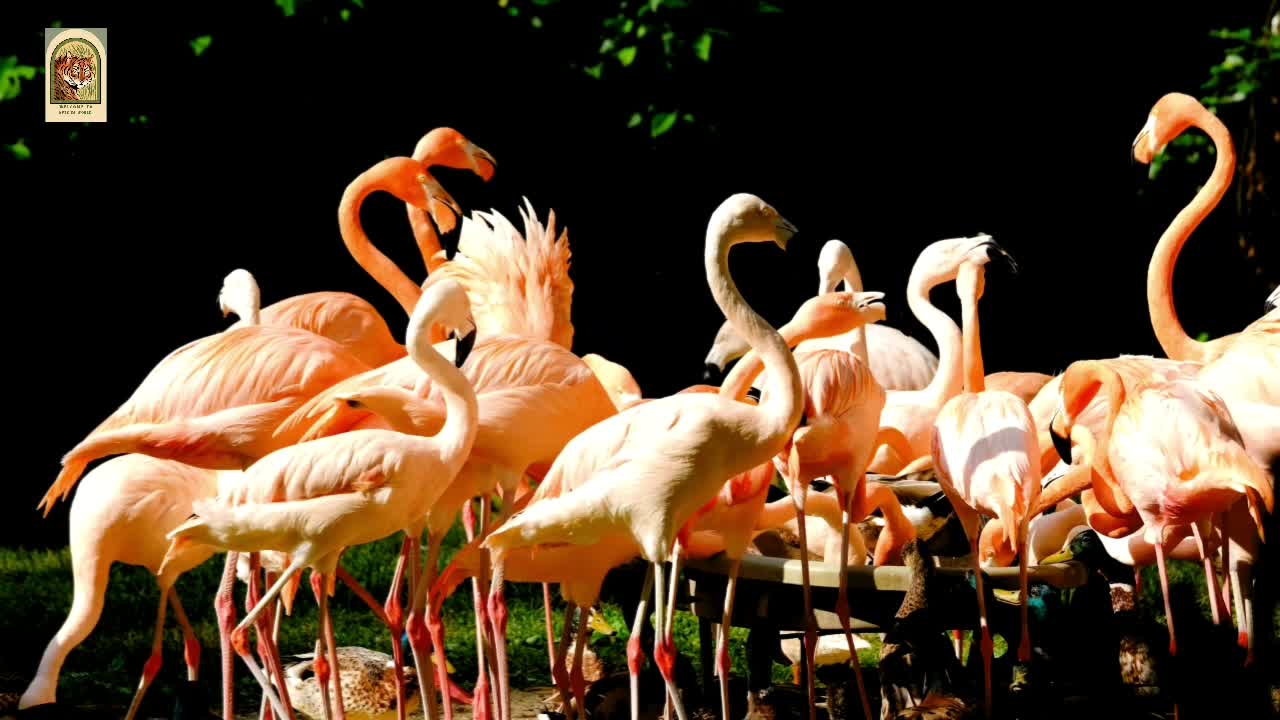Premium Only Content

Why are Flamingos Pink? And Other Flamingo Facts
1. Flamingos get their pink color from their food.
Flamingos really are what they eat. Many plants produce natural red, yellow or orange pigments, called carotenoids. Carotenoids give carrots their orange color or turn ripe tomatoes red. They are also found in the microscopic algae that brine shrimp eat. As a flamingo dines on algae and brine shrimp, its body metabolizes the pigments — turning its feathers pink.
2. Flamingos are filter feeders and turn their heads “upside down” to eat.
The term filter feeder may conjure images of baleen whales or oyster reefs, but flamingos are filter feeders too. They eat algae, small seeds, tiny crustaceans (like brine shrimp), fly larvae, and other plants and animals that live in shallow waters.
When it’s time to eat, a flamingo will place its head upside down in the water with its bill pointed at its feet. It then sweeps its head side-to-side, using its tongue to pump water in and out of its bill. Comb-like plates along the edge of the bill create a filter for water to rush out, while trapping food inside.
In warm climates, flamingos keep cool by standing in water. Bird House keepers apply this natural thermoregulation to keep the Zoo’s flock warm in the winter, too. The flamingo pool is heated to 70 degrees Fahrenheit to keep the birds comfortable — even when it’s snowing.
3. A group of flamingos is called a flamboyance.
A group of crows is called a murder, and a group of geese is called a gaggle. So, what is a group of flamingos called? A flamboyance! Other collective nouns for flamingos include stand, colony and pat.
4. There are six flamingo species.
In addition to Caribbean flamingos, there are lesser, greater, James’s (or Puna), Chilean and Andean flamingos. Greater flamingos are found in parts of Africa, Asia, and Europe. They are the largest and tallest flamingo species.
Chilean, Andean, and James’s flamingos are found only in South America. Andean flamingos are the rarest of the six species, with fewer than 40,000 birds. Lesser flamingos are found in parts of Africa and southern Asia. They are the smallest flamingos and the most abundant. There are more than 2 million lesser flamingos brightening skies and shores with their pink plumage.
5. Don’t let your eyes deceive you — a flamingo’s knees don’t bend backward!
Flamingo legs actually bend just like human legs. What looks like a flamingo's knee is really its ankle joint. A flamingo’s knees are located higher up the legs, hidden by the body and feathers. Confused? Think of a flamingo as standing on tiptoe. When the leg bends, it’s the ankle you see hinging.
6. Some flamingos live in extreme environments.
Flamingos are typically found in shallow saltwater or brackish waters (where saltwater and freshwater mix). But some flamingo species breed and raise their young in extremely salty bodies of water, called alkaline or “soda” lakes. The high concentration of carbonate salts in these lakes is so corrosive that it can burn the skin, making the water uninhabitable for most animals.
Researchers are still uncovering the unique aspects of a flamingo’s physiology — like tough leg skin — that help it survive such harsh waters. The high salt can still be deadly for some flamingo chicks if salt rings build up on their legs, making it impossible for them to walk.
7. Flamingo parents feed their chicks a liquid they secrete, called crop milk.
A flamingo’s “milk” is produced in its crop (part of its throat) and then brought up through its mouth. It may sound icky, but a flamingo’s crop milk is chock-full of healthy proteins and fats. Both parents can produce crop milk to feed a flamingo chick until it is old enough to eat on its own.
8. Yes, flamingos can fly.
You may be used to seeing flamingos gathered in large groups on the ground, but they also take flight. Some flamingos will travel to breed, migrate to a new body of water as seasons change, or move to warmer, lower-altitude areas for the winter. If flamingos are traveling long distances, they often go by night.
9. Flamingos can sleep standing on one leg.
Flamingos can stand on one foot for long periods of time — even long enough to fall asleep. But, why do they perform this balancing act? Research suggests that flamingos use more muscle power when standing on two legs, so standing on one leg may be less tiring.
Scientists also believe that a one-legged stance may help flamingos stay warm. Birds lose body heat through their limbs.
-
 19:59
19:59
Neil McCoy-Ward
17 hours ago🇺🇸 $5,128.21 DOGE Stimulus Check Refund?! Here’s What You Need to Know!
26.7K20 -
 29:22
29:22
Degenerate Jay
20 hours ago $1.62 earnedIs Captain America: Brave New World That Bad? - Movie Review
22.8K4 -
 2:35
2:35
Mrgunsngear
19 hours ago $2.15 earnedFrying Pan As Improvised Body Armor?
32.5K19 -
 9:07
9:07
Silver Dragons
18 hours agoThis GOLD REVALUATION Will Change Everything
36.9K7 -
 9:16
9:16
MudandMunitions
19 hours agoGriffin Armament 3x Prism Optic Unboxing and First Impressions! The Ultimate Tactical Upgrade
21K1 -
 6:01
6:01
John Crump News
18 hours ago $0.61 earnedGOA vs. Philly: The Fight Starts!
19K3 -
 3:03:35
3:03:35
TimcastIRL
13 hours agoTrump Just FIRED OVER 6,700 IRS Agents In PURGE, Democrats SOMEHOW Angry w/Chloe Cole | Timcast IRL
216K331 -
 1:39:48
1:39:48
Kim Iversen
15 hours agoThe Measles Fear Hoax: How They’re Using an Outbreak to Smear RFK Jr.
136K117 -
 1:18:19
1:18:19
Glenn Greenwald
14 hours agoRumble & Truth Social Sue Brazil’s Chief Censor Moraes in US Court; DC Establishment Melts Down Over Trump's Ukraine Policy | SYSTEM UPDATE #409
156K147 -
 1:33:39
1:33:39
Redacted News
17 hours agoBREAKING! Europe goes NUCLEAR against Trump over pushing for PEACE in Ukraine | Redacted
215K290